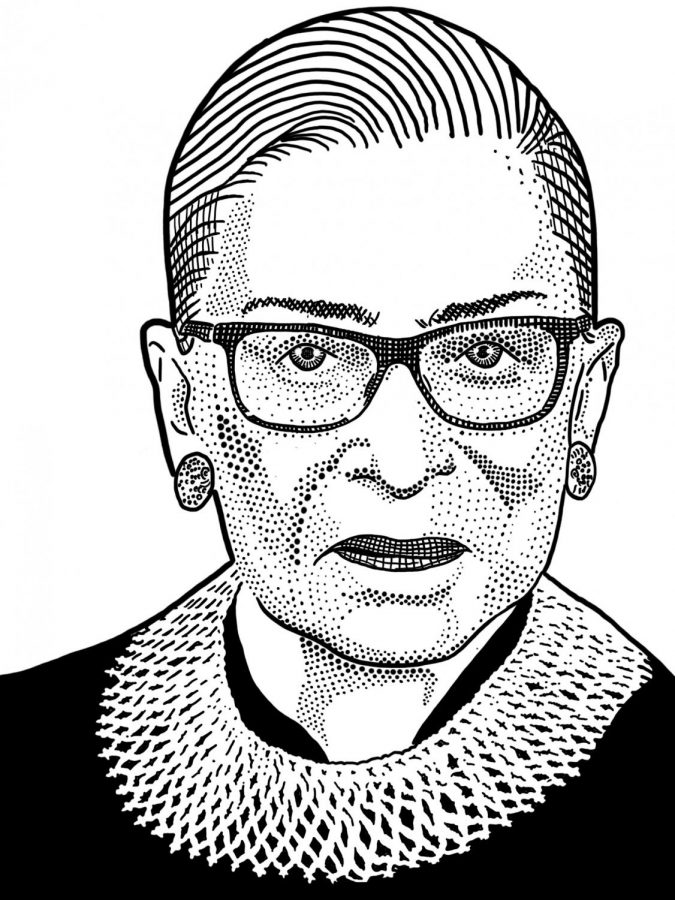Community Reacts to Ruth Bader Ginsburg’s Death
October 6, 2020
On September 18, U.S. Supreme Court Associate Justice Ruth Bader Ginsburg passed away following a long battle with cancer.
A figure admired by many, Justice Ginsburg had a profound impact on many in the United States, including some students and faculty here.
Humanities Department Co-Chair and Women’s Studies teacher Kelly Neely was saddened to hear about Ginsburg’s passing.
“Not only did she focus her career on equality for women, she did so for the equality of everyone across the board in fighting for equal dignity and justice under the law,” Neely said.
“She encountered resistance in her educational and career paths because she was a woman and fought for many of the choices we take for granted today regarding our career paths, our financial independence, our agency over our own bodies, and our right to equal pay for equal work,” Neely further explained. “She was a true leader of this country, and I am grateful for all she contributed to our lives.”
Many students agree with Neely, expressing admiration and high regard for the longtime human rights activist.
“She was, and still is, an incredible inspiration to me. She was an amazing activist for gender equality and a true legend to me,” Haleigh Jacobs ’23 shared. “Her legacy means having rights, and without her I probably wouldn’t have them today.”
Senate Treasurer Neel Kumar ’22 echoed Jacobs’ thoughts.
“Ruth Bader Ginsburg was an astonishing woman who created a path that allowed women to be themselves without needing acceptance from anyone,” Kumar said. “Unfortunately, we have lost a hero, and as American people, we have to make sure that her legacy and actions that got us where we are today will not die.”
Ginsburg’s passing is leaving many feeling uncertain about the future of the Supreme Court’s rulings, with her dying wish to not be replaced until after the November Presidential Election in jeopardy after President Donald Trump’s nomination of conservative jurist Amy Coney Barrett.
Barrett’s confirmation would give the Supreme Court a 6-3 conservative to progressive majority, prompting the fear of the possible overturning of progressive rulings such as Roe v. Wade, which granted reproductive rights to many Americans amid the pro-choice movement, among other rulings protecting the human rights of LGBTQ+ people, disabled individuals, people of color, and other marginalized groups.
“I honestly don’t know what will happen now that Ginsburg is gone, but I do know that we will stand together and not let anyone destroy what she worked so hard on creating,” Kumar said.
Middle School Senate President Stephanie Altschul ’25 recounted Ginsburg’s legacy in her speech at Opening Convocation, which the School held two weeks ago. Altschul is no stranger to speaking up about social justice, using platforms like Instagram and other speaking opportunities to raise awareness about issues and current events—Ginsburg’s legacy being one of them.
“In her many years serving on the Supreme Court, Ruth Bader Ginsburg did more for women in America than countless others in their entire lifetimes,” Altschul said. “Through her work, she became an inspiration to millions, and opened doors that will continue to help people all over this country. Her legacy constantly reminds me that there is hope, all around us, and that hard work and determination are all we need.”
During Upper School Morning Meeting on the Monday following Ginsburg’s death, Supreme Court and Criminal Law teacher Cassandra Abodeely shared insight on how the community can carry Ginsburg’s legacy onward.
“She really fought for this, and I think women my age and yours really need to recognize her as one of these women whose shoulders we stand on as we move forward,” Abodeely told the Upper School.
Memorials honoring Justice Ginsburg took over parts of Capitol Hill as she lay in state at the Supreme Court. She was buried on September 29 at the Arlington National Cemetery in Virginia.
























































Maxine Baca Zinn • Oct 15, 2020 at 10:34 am
What an outstanding article highlighting RBG’s greatness.